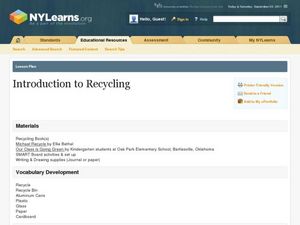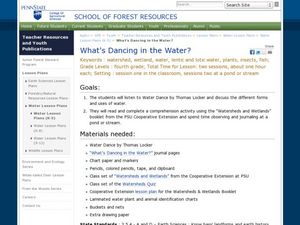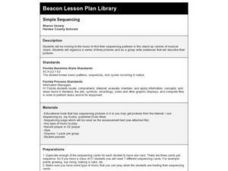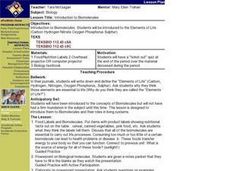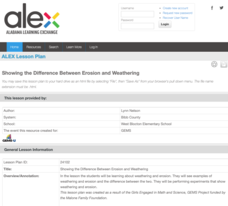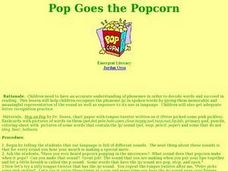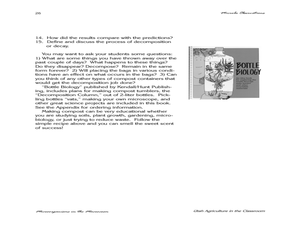Curated OER
Introduction to Recycling
Students read a story about recycling, and then identify 3 different objects that can be recycled on a worksheet of numerous items. In this recycling lesson plan, students also write a sentence about recycling.
Curated OER
Erosion Explosion
Ninth graders explore soil erosion. Through a class discussion, they examine soil conservation methods. Given a potted plant, 9th graders observe the effects of erosion when water is poured over the soil. Students brainstorm terms...
Curated OER
Floating Soap
Students explore the density of soap. In this science lesson, students conduct an experiment to find which types of soap will float. Students make a hypothesis and record their observations.
Curated OER
What's Dancing in the Water?
Young scholars learn about watershed, as well as the different forms and uses of water. In this water forms lesson plan, students brainstorm water sources and uses. Young scholars read the book Water Dance and discuss water examples....
Curated OER
Introduction to Earth Sun Relationships Incorporating P.E.
Third graders investigate space science by performing physical activities. In this solar system instructional activity, 3rd graders perform a relay activitiy with their class in which they race between different "planets". ...
Curated OER
George Washington Carver
Students write three contributions made to society by George Washington Carver. They complete a handout listing the four things plants need to grow.
Curated OER
Simple Sequencing
Fourth graders play a stand up version of musical chairs to find their sequencing partners. In this music and language arts lesson, 4th graders enjoy a game that requires them to organize a series of three pictures, then write sentences...
Curated OER
The Meaning of Dreams
Learners reflect on the meaning of dreams and how scientists study dreams. They read and discuss the article "Winding Through Big Dreams Are the Threads of Our Lives." They write personal summaries and analysis of memorable, vivid dreams.
Curated OER
Atom and Eve
Students research and define an atom using a concept map. They design and create a model of an atom, labelling all the parts, and write a journal entry.
Curated OER
Properties of Air
Students conduct investigations to demonstrate and learn that air takes up space, and puts pressure, or pushes, on everything around it. They conduct experiments to learn about feeling air pressure and measuring air pressure. Prior to...
Curated OER
Recognizing and Describing Chemical Changes
Seventh graders distinguish between physical and chemical changes in both natural and technological settings. They identify the reactants and products for a given chemical reaction. they then write simple chemical equations given the...
Curated OER
Magnets
Students investigate the magnetic attraction of different materials by observing a demonstration, and review the words "attraction" and "materials." Next they conduct exploration of a number of materials which have different properties...
Curated OER
One + One = One
Students develop problem solving skills while developing writing skills. They assume responsibility for a sugar or egg "baby" and journal the experiences. In addition, they create a birth certificate and a holder.
Curated OER
Kamchatka: Just Gushing with Geysers!
Students explore geysers. They identify the parts of the geyser and how it works. Students create a working model of a geyser. They write a brief summary about their geyser.
Curated OER
Introduction to Biomolecules
Students are introduced to biomolecules and their roles in livin systems. They are introduced to the "Elements of Life." Students write down and define the "Elements of Life." They are asked why they think those elements are essential...
Curated OER
Living and Non-Living
Students discover the basic needs of life. In this science lesson plan, students explore how all living things need air, water, food and shelter
Alabama Learning Exchange
Showing the Difference between Erosion and Weathering
Learners explore the concepts of weathering and erosion. After viewing pictures of both erosion and weathering, young scholars work in pairs to conduct an experiment with sugar cubes, water, sand, and a straw. They write their...
Curated OER
Becoming a Meteorologist
Students identify the job of a meteorologist. In this meteorologist lesson, students read Cloudy with a Chance of Meatballs and view clips of weather forecasts. Students visit the Weather Channel website and sing a weather song. Students...
Curated OER
POP! Goes the Popcorn!
Students complete a variety of activities based on examining corn and popcorn as one of the major crops of Kansas. They journal the results of the multidisciplinary activities in this unit.
Curated OER
Space Exploration
Sixth graders identify and interpret the following: What is space?, Space Race, Living in space?, Man on the Moon, Astronaut training; students compare/contrast US and Russia space exploration. Students write a letter of application to...
Curated OER
Rotten Truth
Students complete activities to study decomposition. In this decomposition lesson, students work in pairs to observe a decay buffet experiment. Students keep compost bag journals. Students define and discuss the process of decomposition.
Curated OER
Alternative to the Frog Dissection
Students conduct internet research about frog anatomy and construct a journal that chronicles their explorations. They write descriptions of each system of the frog and the functions of the organs.
Curated OER
The Earth's Crust
Young scholars use clay to form models of the different landforms and then complete a data table using a map, atlas, or the Internet to locate famous landforms in the United States. Students complete various activities, writing down...
Curated OER
Earth's Seasons
Sixth graders review the relationship between the Sun and the Earth. In groups, they use a globe and flashlights to show the shadows on the Earth during the different seasons. To end the lesson, they write in their journals about their...
